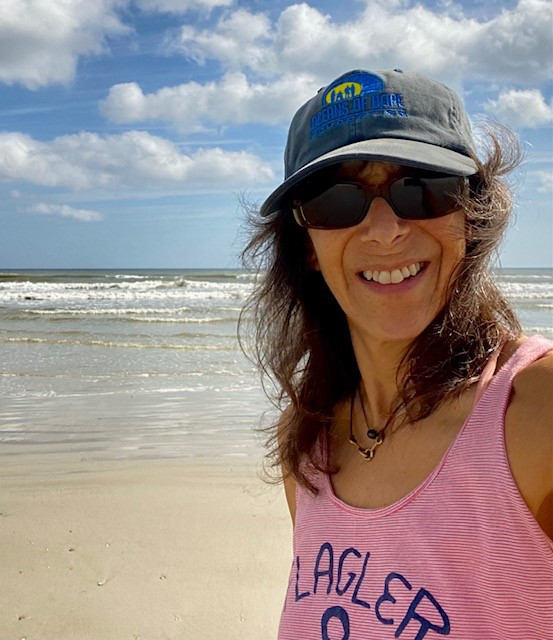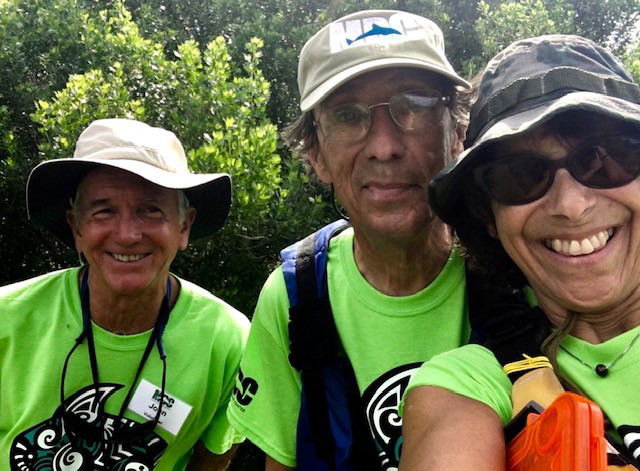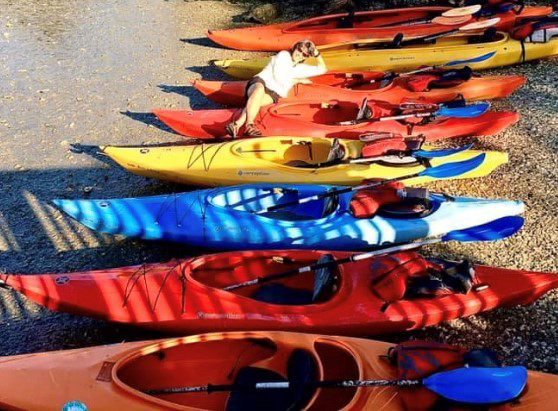Native New Englander Susan Engelman first rolled up her sleeves to volunteer at the Marine Discovery Center in 2017 after retiring and relocating to Florida. She went from treating cancer patients as a radiation therapist in the Boston area to building oyster bags, helping eradicate invasive species and rebuilding shorelines in New Smyrna Beach.
A former president of the Rhode Island Canoe and Kayak Association, Engelman brought her deep experience to MDC’s kayak program as a volunteer sweep, often taking guests aside to quickly fine-tune their paddling techniques during tours.
Read more about Susan in MDC’s June 2021 Volunteer Spotlight interview with staff writer Lisa Mickey:
Q: Where did you grow up?
A: I was born in Bridgeport, Connecticut, and grew up in nearby Stratford, Conn.
Q: What did you study after high school?
A: I went to school for two years to become a radiation therapist and then followed my soon-to-be husband to Massachusetts, where we lived and had two children. I was there until I moved to Florida.
Q: Where did you work as a radiation therapist?
A: I did my training at Yale New Haven Hospital in New Haven, Conn., and then when Rich went to Massachusetts, I followed him. I worked at Boston University Medical Center for nine years and had my son. After I went back to work, I went to St. Elizabeth’s Medical Center right outside of Boston because they were starting a day care. I stayed there for 24 years. In all, I worked as a radiation therapist for more than 40 years.
Q: When did you retire?
A: I bought a place in New Smyrna Beach in July 2016, retired in December 2016, and moved here in 2017. I was trying to sell my house in Massachusetts, but the sale fell through. I kept my plans and moved to Florida, but whenever I went home [to Massachusetts], it was kind of like camping because I went home to a mostly empty house with a mattress on the floor, a chair that I could watch TV and a camping lamp. All of my furniture was in Florida.
Q: What made you move to New Smyrna Beach?
A: My mom moved down here in 1979 right after I got married — really before New Smyrna was very well known. They had T-shirts back then that said, “Where the hell is New Smyrna Beach?” Mom moved into a new house in the new development of Fairgreen and that’s where she lived for more than 40 years. I came down here to help take care of her. Rich and I had divorced by that time, but he still owned the house with me. I realized it was time for me to move closer to my mother, so I found my place at Bouchelle Island. It just fit. It was near my mother, near town, near the water and it had a garage. I came down with two cars, two bikes and two kayaks.
Q: How did you start volunteering at MDC?
A: While I was coming down to visit my mom, I took a tour back when MDC was across the street at the former location on the North Causeway. I thought it was fun. When I moved here, I got a license to practice radiation therapy in Florida, but my mom’s schedule was too complicated. I decided to stop working, but I wanted to do something. I wanted to paddle, so I figured I’d go check out MDC.
Q: How did you get involved at MDC?
A: I think I over-extended myself when I first got involved three years ago because I worked with the Sea Squirts in the education department, the oyster program, shoreline restoration, Brazilian pepper removal and as a volunteer kayak sweep and then all of that just became too much. Something had to go. And then Covid hit and everything just changed. At least we could do some of the outdoor activities.
Q: What did you like about the activities in which you were involved as a volunteer?
A: I liked the physicality of it because back home in Massachusetts, I did all my own lawn care, fall leaf cleanup and winter snow clearance, so I was always outside. I needed something that I could be physical with. That’s how I got involved with MDC’s oyster program because I knew that we would shovel and bag oyster shells and lift and haul the bags. That was fine with me because I had always hauled leaves and snow, and I missed my physical life. Plus, it was for a good cause.
Q: The oyster program can be a hot, heavy and sometimes painful place to volunteer. What appealed to you about that?
A: I never minded that part. Even clearing the Brazilian pepper didn’t bother me. When we cut and hauled branches, it felt like the same kind of outdoor work I did at home. I tried to do a little of everything to learn what I liked and disliked doing.
Q: Last year was a strange year for volunteers with Covid. How did it affect you?
A: Once Covid hit, a lot of things just stopped for me. I only did the things that I felt I was safe doing. I would walk on the beach, ride my bike, kayak and take out my boat for little trips, but it was a while for me to feel comfortable enough to come back to MDC to volunteer. And then the oyster program changed and I really didn’t want to work with the new process of using cement and wire.
Q: Do you volunteer in other places?
A: I got involved in the adaptive kayak program early last year with Oceans of Hope out at Battle Island. I felt that I really could do something worthy. Even when I was back in Massachusetts, I always wanted to learn about adaptive paddling to help others enjoy kayaking. As soon as they brought the Oceans of Hope kayak trips back this year after Covid, I was back out there helping. I also volunteer at the Methodist Church to help serve the Thanksgiving Community Meal.
Q: It’s a lot of responsibility getting physically challenged individuals from a wheelchair into a kayak.
A: Yes, but don’t forget that I worked in the medical field for 40 years. Lifting patients and making sure they are stable was part of something I had been doing for a long time. I am part of a group helping these individuals. I help as a co-leader or a paddle partner out on the water. It’s been great because it gives me the chance to paddle and to help give back some of the things that I love.
Q: Do you have any hobbies?
A: I’m not crafty or artistic, but I enjoy photography and I take a lot of pictures. If I’m upset about something and go out and take pictures, I just focus and forget about everything that’s bad. I still do yoga at home, but I haven’t felt comfortable doing it in a public indoor space. Mostly, I walk every day, try to ride my bike, paddle or do something physical each day. I need to know that I’ve worked myself a bit.
Q: Where are your adult children these days?
A: My daughter is 28 and lives in Boston and my son is 30 and lives here in New Smyrna Beach.
Q: What excites you about being a part of the MDC’s mission here with the Indian River Lagoon?
A: I like to know that the environment is being taken care of and that I can help out. I’m not a Florida naturalist, so I don’t know all the species of the lagoon, but do I appreciate them? Absolutely! Do I want a clean lagoon and a great shoreline? Of course, I do!
Q: You have been here long enough to see some changes at MDC. Is there something here that stands out?
A: I think the way MDC came through Covid is pretty remarkable. We were able to stay afloat. Kudos to Chad [Truxall] who kept it all together during the pandemic. I think MDC’s programs are great and I like the way the activities at the amphitheater and at MDC are trying to come back and be as popular as they were before Covid. That just shows a cohesive group at MDC.
Q: Does it feel like MDC is taking another step into our community’s awareness?
A: Absolutely. It’s always an evolving thing and it helps that we’re on social media. I can post pictures of things I see in my travels or things that are really cool that I see around me. The more that things “get out there,” the better it is for everybody to know what’s going on here.
Q: Has there been a highlight for you as an MDC volunteer?
A: The kayak program. I want people to be happy on the water and I want people to be as joyful on the water as I am. I also want them to be safe and effective. Sometimes it might seem that I’m shouting orders for them to paddle correctly, but it’s because I know that they will come back and feel tired and not feel so great about their experience. I want people to come back happy. If I ask them to turn their paddle around, it’s not because I’m being cranky. I want them to paddle correctly and to know how to do it right so they can enjoy it more. Not only do our guests leave with good information from our naturalists, but they may also leave feeling like they want kayaking to become one of their hobbies.
Q: As the former head of a state kayak association, you bring an extra benefit to MDC’s kayak program as a volunteer.
A: Well, when I left to come down here, I lost all of my paddling buddies and all of my hiking buddies. I needed to fill that void, so that’s what MDC did for me. It gave me the chance to go out safely. I didn’t feel like joining a paddling group immediately because it’s difficult to transport my heavy 14½-foot touring kayak and put it on the car by myself.
Q: You could be out paddling. Why do you spend time volunteering?
A: It breaks up the mundane errands of each day, but when you volunteer, it’s not only about you. It’s about someone else. Volunteering at both MDC and Oceans of Hope puts life in perspective because you see so many different people from so many different walks of life, especially with the Oceans of Hope participants, whose physical bodies may be compromised. The whole total package of volunteering is about making someone else’s day a little better.







Follow Us!